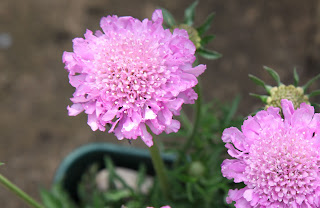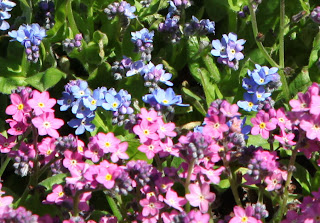The day my cousin and her family visited, I cut a few bluebells and Yellow Cheerfulness narcissi and put them in my little bottle set. My cousin also has a baby boy, and there is something about the gentle blue and yellow colours and the sweet, small flowers that makes me think that a bunch of these would be lovely to welcome a new baby.
Bluebells represent constancy, which is a great sentiment for a baby starting out in life. To me, narcissi represent new beginnings, although when I first looked them up I could see that there were different meanings. There’s an interesting
article specifically about the different meanings for narcissi by The Daffodil Society.
I avoid using flowers or herbs in floristry that only seem to have a negative meaning, such as basil which means hate. Having said that, if someone especially wanted basil in their flowers, then I would use it. I remember using this ethereal-looking
photoshoot in lavender fields on the Ruffled blog as inspiration when I was doing my floristry diploma; lavender symbolises mistrust, but it's hard to care when it creates such a dreamy blue backdrop. Scabious doesn't exactly have a pleasant flower meaning, but I find the flower far too pretty for me to care. I enjoyed picking them at
Blooming Green near Maidstone and they added to the cottage garden feel of the wedding flowers I was doing, and I saw rows of them when I visited
Green and Gorgeous near Oxford. I'm growing some pink and red scabious now and I can't wait to mix them up with other flowers that I'm growing. These are my 'Pink Mist' scabious.
Generally, when there are contradictory flower meanings (e.g. hydrangea, which can mean heartfelt emotion and gratitude at being understood, or heartlessness), I choose the positive sentiment, which is the sentiment that I wish to convey. And I think that personal sentiment, ultimately, decides what flowers symbolise when they are given or used for an occasion. This is especially the case when it comes to using seasonal flowers – I think it’s great if people decide to use peonies for early summer weddings or cherry blossom for spring ones, rather than relying solely on air-freighted flowers.
This is a big bouquet I did for my friend Jo's grandparents, who were celebrating their anniversary on the same autumn day that Jo got married. Hydrangea symbolised heartfelt emotion, the snowberries fate, and the lilac 'Memory Lane' roses, apart from their appropriate name, stood for enchantment and love at first sight. Definitely no heartlessness here!
I've mentioned this before, but Mandy Kirkby's book, The Language of Flowers, is a wonderful introduction to the symbolism of flowers. She has a lovely writing style and the cover and illustrations by Katie Tooke are beautiful. This book, along with the RHS Encyclopaedia of Garden Plants, has been my dusk and dawn reading for a few years.






















































